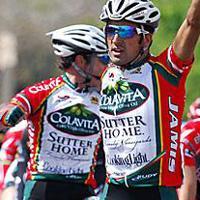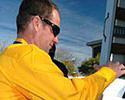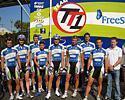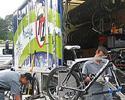
Recently on Cyclingnews.com |
News feature, August 28, 2008
State of the Peloton: North America
The North American peloton* will be undergoing some major changes after the 2008 season. The potential loss of two big teams could produce a sea change of sorts, flooding the market with top talent. Cyclingnews' Mark Zalewski gives a 'State of the Peloton' report, including who is staying, who could be going and who might be growing because of it. In part two of this three-part feature, he looks at the mid-level teams that are surviving.
Also see part one, and check back for part three: the up and comers.
Price of the pump
Oil prices are a major factor in team budgets, since riders need to either fly or drive to races and team staff need to haul a lot of equipment in big gas-guzzling vehicles from one coast to another, and often back again the next week. Even if the racing calendar was not a mess in this regard, the high price of gas still is a factor. An oil company as a title sponsor would be ideal at this time. To put how much oil prices affecting a cycling team's budget in perspective, consider the following rudimentary budget for travel to one major race, the upcoming Tour of Missouri, for an average US team. People: Eight riders, two directors, two mechanics, two soigneurs. Vehicles: Two team cars, one team truck, and one team van. Recent studies show that airfares this summer are up an average of 15%. A USA Today article cited a Harrell Associates study showing that the average cheapest coach fare in June and July, the peak of the cycling season, was 16% more expensive than in 2007, with some fares over 216% higher! Assuming all the riders/directors live in Colorado and fly out of Denver, the cheapest fare on the web in August was $280, for a total of $2,800. Why not twelve tickets? Four vehicles need to be driven from the most recent race in Greenville, South Carolina to Missouri – about 930 miles. (Ah, the life of a team mechanic and soigneur.) AAA reported the average price of gas as $3.667, up from $2.745 a year ago.) Using the EPA and DOE calculations from fueleconomy.gov, the costs break down as follows: The median fuel cost for a station wagon is $4.33 to drive 25 miles. The trip cost would be $161.08 per car or $322.16. The median fuel cost for a 15-passenger van is $6.23 to drive 25 miles. For the trip, the cost would be $231.76. The EPA does not require trucks over a certain size to post MPG ratings, so a very unscientific calculation based off moving truck estimates shows that a fully loaded 26-foot truck will average about 10 MPG, giving a cost of $341.03. The fuel costs alone just to get everyone and everything to the start of the race in Kansas City totals $3694.95. Last year, that cost would have been $2765.19. Over a season, that difference adds up exponentially, particularly considering races with much longer air travel than from Colorado to Missouri. (If the team switched to Smart Cars for their team cars, they could save $58.67 per car for the trip, though not be able to carry much in the way of spare wheels or bikes during a race.) |

|
Moving down the NRC team rankings for the rest of the US peloton, the opportunities afforded to them with the amount of talent on the table ranges from a chance to step-up to the big leagues to the schadenfreude of a "Got Milk" commercial. Riders may be available but budgets do not magically increase just because of this. As well, teams often say they prefer to stay loyal to their own riders and maintain a strong and cohesive team core. Whether or not this is true or merely a result of not having a big enough budget to sign additional talent is a trade secret.
Take for example the Colavita-Sutter Home team, which sits third in the NRC rankings. Team owner John Profaci has been around long enough to see situations like this in the past. "After being in this for a few years now I don't enjoy the recruiting that goes on in August. I basically resigned the whole team and if there is room for a new player, great. But I am happy with the teamwork and morale we have now. I need to stick my guns and stick to my squad. We are very excited and they work great together."
Still the chance to fill a gap in the team is always a thought. "We are missing an overall GC and a time trialist, that is no secret there. I used to get e-mails, but no top names have come my way so far. If one comes our way I would be happy to take that call."

|
There were rumours that the second year programme Successfulliving.com was in financial distress, but director Steve Hegg said that all issues have been worked out. However, the team that currently sits fifth on the NRC will return smaller next season – or as he put it, leaner and meaner.
"I had a meeting with [the owner] in July and he is totally into it," said Hegg. "We found a way that we can operate. I personally wanted to make it smaller because we need to run more to the limit with the guys. I want to put together an eight-man hit squad, a wrecking crew! And have two in reserve. It sucks the funds when you have four guys sitting around doing nothing while the other eight are racing."
Hegg, a former racer himself, knows a lot about the current situation and says there will be a reality check for some riders. "It puts me in a bad position because the budget is not going to change much. Cycling is like a drug because guys will end up doing the same job for half the money. It tends to make for some ill will. We have been very lucky with this team that we have been able to put together a group of guys that are cohesive. No monster prima donna or a guy that needs special needs like me when I was racing! I am very blessed with the guys I have and the relationship I have with my sponsor."
For the Kelly Benefits Strategies-Medifast team, also just two years out of the blocks, the programme has progressed as planned, launching its first foray into European racing last month. "From all indications the team is growing at a huge rate and we plan on continuing the trajectory as planned," said team owner Charles Aaron. "We are not the same team we were last year. From an official stance we have some cool things going on."
Performance director Jonas Carney said that this would continue as planned with no signs of wavering sponsorship. "We have plans to expand in 2009. As a new programme with a modest budget, we have quickly grown into a team that can go head to head with the best in North America every weekend. We plan to continue on the same path, stick to our values, and become one of the dominant teams. We also plan to spend more time racing internationally, especially in Europe."
But for him the talent likely available does not change his planning. "Our philosophy differs from most teams; the market being flooded does not really change anything for us. Other teams will probably sit back and scoop up riders on the cheap or buy one big star rider. I don't think those approaches make for a good team. We aren't just hiring guys because they are a good deal, or have a good resume. We are building a team, and there are only a handful of guys out there that would fit in our programme. The guys we will consider are the same, regardless of whether the market is flooded or not. Of the two big US programmes that are folding, I am currently looking at one person."

|
Someone who has scene just about anything and everything that can happen to the US peloton is Team Type 1's manager Tom Schuler, who successfully ran the Saturn programme among others. "I've been in that position before," he said. "It's never good for the health of the sport but at the same time you go back in history on the domestic scene and teams always seem to pop up to fill the void. I don't think it will take up all the capacity because it's not just any team but two of the impacting teams on the scene. So it is a true contraction, but we've had a significant growth in the last few years."
Team Type 1 might benefit more than most teams from this buyer's market, as the team was put together at such a late date last year that it was at a disadvantage in the market. "We got started late last year so we weren't looking at as many riders, but for this year we have the advantage of talking to guys within the normal time period. And the market looks to be late and the market will be pushing down the salaries as well."
(Additional reporting from Kirsten Robbins. * Only UCI registered trade teams were reviewed for this story.)
Go back to part one. Stay tuned for part three.
Photography
For a thumbnail gallery of these images, click here
Images by Mitch Clinton/www.clintonphoto.com
- Lucas Sebastian Haedo helped John Profaci's Colavita Sutter Home team move up the ranks, despite "missing an overall GC and a time trialist."
- Successfulliving.com director Steve Hegg at the Tour of California
Images by Glen Chadwick
- Tom Schuler's Team Type 1 2008 team
- Mechanics feel the pinch of higher gas prices

